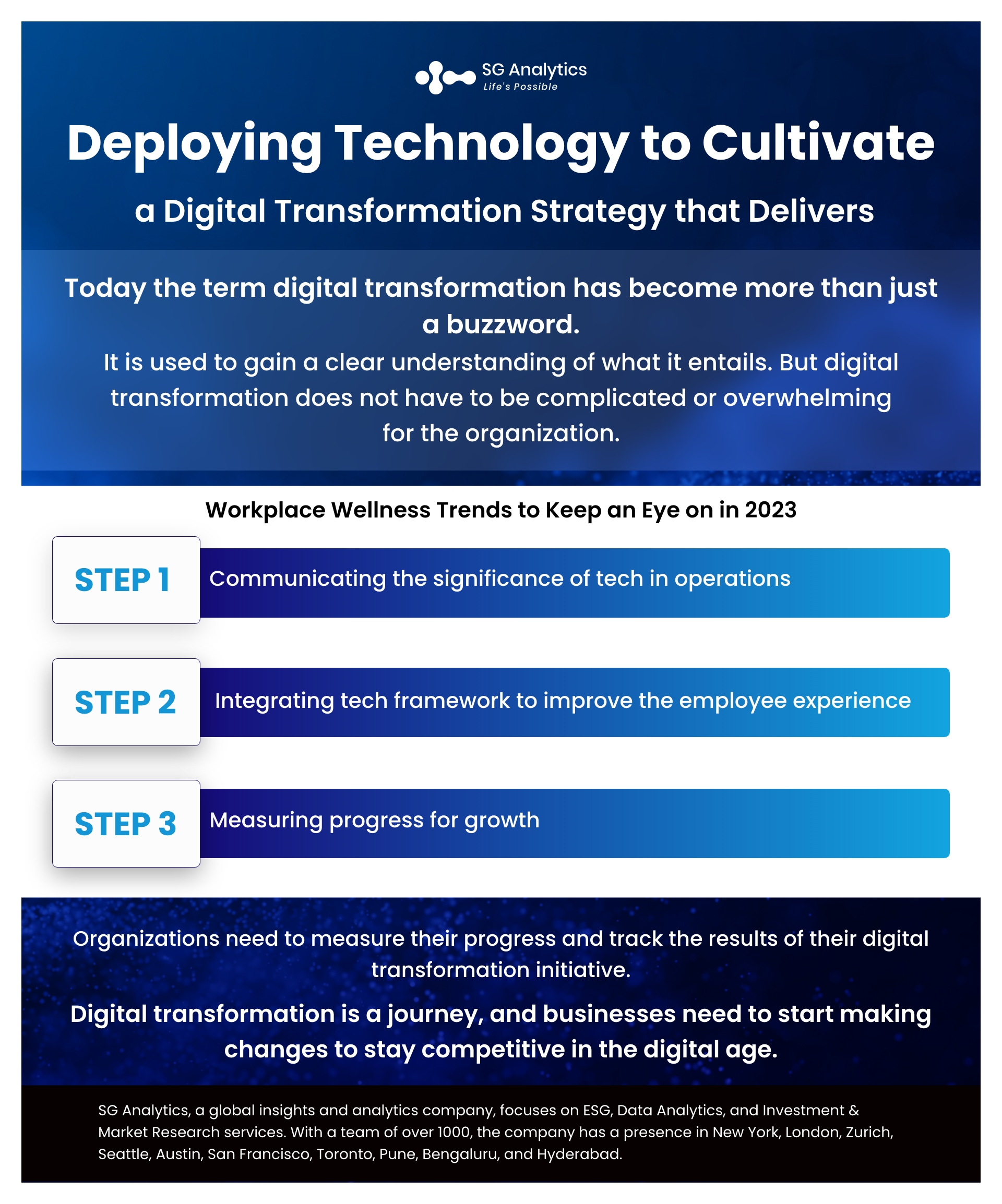Today the term digital transformation has become more than just a buzzword. It is often used to gain a clear understanding of what it entails. However, digital transformation does not have to be complicated or overwhelming for the organization. In its simplest form, digital transformation entails employing digital technologies to create new or transform existing processes, products, and services. And this can be accomplished in several ways, which include-
-
Automating manual operations
-
Introducing self-service channels for online customer
-
Integrating data and analytics to drive precise decisions
-
Developing digital products and services
While digital transformation can imply different things to different organizations, it all depends on identifying and specifying the needs and goals. But the bottom line is that all businesses need to be conscious of the existing opportunities that digital technologies present and ways to use them to drive growth in the competitive market.

By 2025, the global expenditure of organizations on digital transformation technologies and services is estimated to reach $2.8 trillion. Digital transformation today is on the executive agenda of many organizations to prioritize transformation. It is all about integrating technology to enhance the customer experience and adapt to the digital economy to expand its digital capabilities.
Read more: Debunking the Myths - Does Innovation Holds Back Digital Transformation?
Organizations that implement digital transformation have witnessed better customer interaction along with higher operational efficiency to promote new products and services. They assist businesses in adapting quickly to changes in consumer behavior and responding to the latest market trends, along with seizing more growth opportunities through digital transformation. All businesses must integrate new tech with old processes. It helps gain a few efficiencies and reap digital transformation's benefits. But it also mandates rethinking processes to focus on outcomes. By 2025, the global expenditure of organizations on digital transformation technologies and services is estimated to reach $2.8 trillion.
Organizational processes are about what people accomplish, and changing these processes means changing behaviors and mindsets. It requires time, a transition mindset, and rethinking various organizational processes. Hence it is only natural that the process is a significant part of digital transformation. This scope of the digital transformation framework is essential to setting up organizational success. While the process may look different depending on the situation, it can include the following:
-
Aligning the desired outcomes for customers
-
Streamlining work activities to create an efficient and functional process

-
Putting process management that focuses on customers and the end-user experience
-
Improving existing framework to account for newly adopted technologies
-
Rethinking strategic decisions about a company process
If you are an organization wanting to implement digital transformation in your organization? Here are a few steps you should undertake to foster the implementation process and ensure that new tech tools do not end up gathering dust.
Read more: Outlook 2023: Top Strategic Technology Challenges
Step 1: Communicating the Significance of Tech in Operations
For any organization, the process of transitioning and incorporating new tech into its operations is long and arduous. It mandates identifying and acknowledging a problem, filtering through a variety of viable solutions, and determining the most viable solutions for the resources. However, integrating new tech, from an end user's perspective, is often perceived as a solution. But for major organizations, it is considered a problem as it requires learning new workflows and developing new habits.

To enhance the process, tech rollouts include campaigns that require communicating with the employees because the new tools are essential and desirable. Often used to describe the process of introducing new tech, the term "rollout" has been finding a significant use in every workplace. And this mechanism is now shifting from a tech-first to a people-first approach in most organizations. Organizations must communicate why this interaction should be encouraged to implement new tech effectively.
Tech solutions in the organizational arena are helping to show the employees. These tech tools assist in automating common operational functions like requesting or enrolling new functional benefits. But the problem with many of these platforms is that they are designed with specific professionals in mind. It is, therefore, important for organizations to introduce new mechanisms and tools necessary to bridge this gap.
Read more: The Age of Digital Transformation: Top AI and ML 2022 Trends
Step 2: Integrating Tech Framework to improve the Employee Experience
Defining the need for why will enable businesses to understand the reason tech is introduced in operations. The next step for them is to define the impact that the tech can have on the employee experience. Communicating how the new tech framework will improve the employee experience is perceived as a critical part of the digital implementation process.

Transparency has come to be a valuable tool for employee empowerment within an organization. With many new tech tools being rolled out, organizations are implementing frameworks to increase transparency in their operations. Task management platforms are being used to identify who is involved, what employees should do, and when their work should be expected. Communications platforms also help in identifying when the employees are online, when they read a message, or when they are responding to a query. But for this level of real-time access, organizations need to facilitate the information to improve the employee experience. However, effective technology helps in improving processes. It enables transformation by enhancing accessibility, flexibility, and operational efficiency, equipping employees to identify the critical elements for their interaction.
Read more: The Next Tech Time Warp: How Will Artificial Intelligence Possibly Change the World?
Step 3: Measuring Progress for Growth
COVID-19 rooted and taught businesses the importance of digitizing operations to keep the company going. But digital transformation strategies are not just inclusive of technology. When a company initiates a substantial change in how an organization operates, the employees are likely to feel the impact. Companies can’t make a momentous change in operations unless people change how they work.
Organizations need to measure their progress and track the results of their digital transformation initiative. This indicates tracking the results of a digital transformation initiative to ensure that it achieves the desired goals. It is important for them to keep track of quantitative and qualitative data to assess digital transformation success accurately. This will also assist in identifying what is working and what’s not, enabling them to adjust as required. Digital transformation is a journey, and businesses need to start making changes to stay competitive in the digital age.

Final Thoughts
Businesses are rolling out new platforms and frameworks that are affecting employees, typically requiring a temporary password and a deadline to log on. While it is interesting that these rollouts are presenting new opportunities, it is slowing down certain processes, resulting in a state of rest on the runway. The problem with technology rollout is that it plays a significant role in the overall success of an organization's digital transformation process.
Many digital transformation initiatives are emerging as tech-first, people-second. They are focusing on tools that equip organizations to bring value to their users. Recent studies have also highlighted that only 30% of digital transformation efforts result in a higher level of performance for the organization. And they are now investing a lot in digital transformation but are gaining very little value. Organizations are transitioning their traditional operations into new processes that mandate some communication about the advanced workload resulting from increased possibilities. It also offers a way that digitalizes multiple operations, thus freeing up employees to provide more personalized attention.
With a presence in New York, San Francisco, Austin, Seattle, Toronto, London, Zurich, Pune, Bengaluru, and Hyderabad, SG Analytics, a pioneer in Research and Analytics, offers tailor-made services to enterprises worldwide.
A leader in the Technology domain, SG Analytics partners with global technology enterprises across market research and scalable analytics. Contact us today if you are in search of combining market research, analytics, and technology capabilities to design compelling business outcomes driven by technology.









